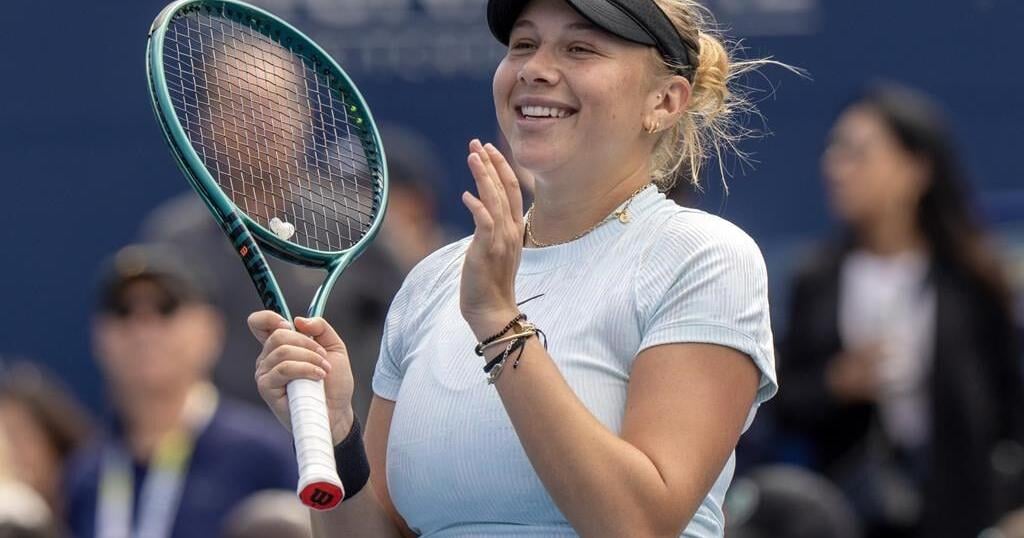TORONTO – Amanda Anisimova took a seat as the unpredictable wind continued to swirl around Sobeys Stadium.
Having dominated the first set and on her heels in the second, the 22-year-old ascending the WTA Tour rankings following an eight-month break to work on her mental health had finally been granted a medical timeout to deal with a blister.
As the trainer taped that bothersome left foot just off Centre Court, Anisimova did her best to regroup and take stock of the situation.
“Trying to relax and calm my nerves,” said the 132nd-ranked player entering this week. “Telling myself to stay calm and just try and push through.”
The pain — and the adversity — was quickly brushed aside.
Anisimova upset fellow American and No. 8 seed Emma Navarro 6-3, 2-6, 6-2 on Sunday to make the women’s singles final at the National Bank Open.
“Huge accomplishment,” she said. “Something I’ve been working really hard towards.”
Anisimova is the lowest-ranked player to make the NBO semis since Sloane Stephens (No. 934) in 2017.
She also picked up her fourth victory against a top-20 opponent this week after previously taking down No. 3 Aryna Sabalenka, No. 12 Daria Kasatakina and No. 17 Anna Kalinskaya.
“I was trying to fight,” Anisimova said. “I’m just happy with how I was able to pull through.”
Her time away from the game — she didn’t play competitively from May 2023 until the Australian Open in January — included going to college for a semester and getting to experience “a normal life” after success early in her career that included making the 2019 French Open semis at age 17.
Anisimov, however, was always going to get back swinging a racket.
“I didn’t want to finish my career on that note,” she said. “I had sacrificed so much and given so much to the sport.”
But there were doubts.
“It’s not easy,” Anisimova said of returning after a long layoff. “But once I started practising and training, everything was going pretty smoothly.”
Defending champion and third-seed Jessica Pegula of the U.S. faced No. 14 Diana Shnaider of Russia in the late semifinal for the other spot in Monday’s title match.
Pegula, ranked No. 6 in the world, owned a 15-2 all-time record at the NBO entering Sunday, including last year’s victory that followed back-to-back final four appearances at the US$3.2-million event.
Shnaider, the tour’s 24th-ranked player, upset No. 1 seed Coco Gauff in the third round before topping No. 6 Liudmila Samsonova in the quarters.
Leylah Fernandez of Laval, Que., and younger sister Bianca met Ottawa’s Gabriela Dabrowski and New Zealand’s Erin Routliffe in one of two doubles semifinals. The winner will face Caroline Dolehide and Desirae Krawczyk after they topped Sofia Kenin and Bethanie Mattek-Sands 6-2, 3-6 (10-7) in another all-American showdown.
Anisimova picked up 12 of the first 13 points against the 15th-ranked Navarro to take a 3-0 lead in a dominant first set after the match was delayed an hour by rain.
With both players taking part in their first WTA 1000 semifinal — one level below the four majors — Anisimova went up a break at 2-1 in the second set.
Navarro, 23, broke back twice to nudge ahead 4-2 and held serve to grab another game before Anisimova called for a trainer to tape that blister.
“I was kind of pissed that I didn’t get a medical timeout earlier,” said Anisimova, who was subsequently broken again to tie the match. “It had been bothering me for quite some time.”
Coming off a quarterfinal showing in Washington that included two qualifying matches, she ignored the pain and went from down love-40 to deuce with Navarro serving tied 1-1 in the third set before breaking her opponent.
The swirling winds at York University on Toronto’s northern boundary have been a story all week, but were even more of a factor Sunday with gusts of more than 40 km/h.
“You could start a point and the wind’s going in one direction,” Navarro said. “And by the end of the point it’s going in a different direction.”
Anisimova said the “stressful” conditions impacted both players.
“It was so difficult,” she said. “We did our best to try and have the best match that we could out there.”
Anisimova picked up another break to go up 5-2 and sealed the match with an ace to grab a spot in the final at Canada’s national championship.
“When she’s hitting her spots she’s really, really tough to beat,” Navarro said. “She can take any ball that her opponent hits and rip to either corner.”
Anisimova will look to keep that going Monday as she continues her climb.
“I’m pretty surprised with how well I’ve been able to do so far,” she said. “I’m still hungry for more.”
This report by The Canadian Press was first published Aug. 11, 2024.
___
Follow @JClipperton_CP on X.

























